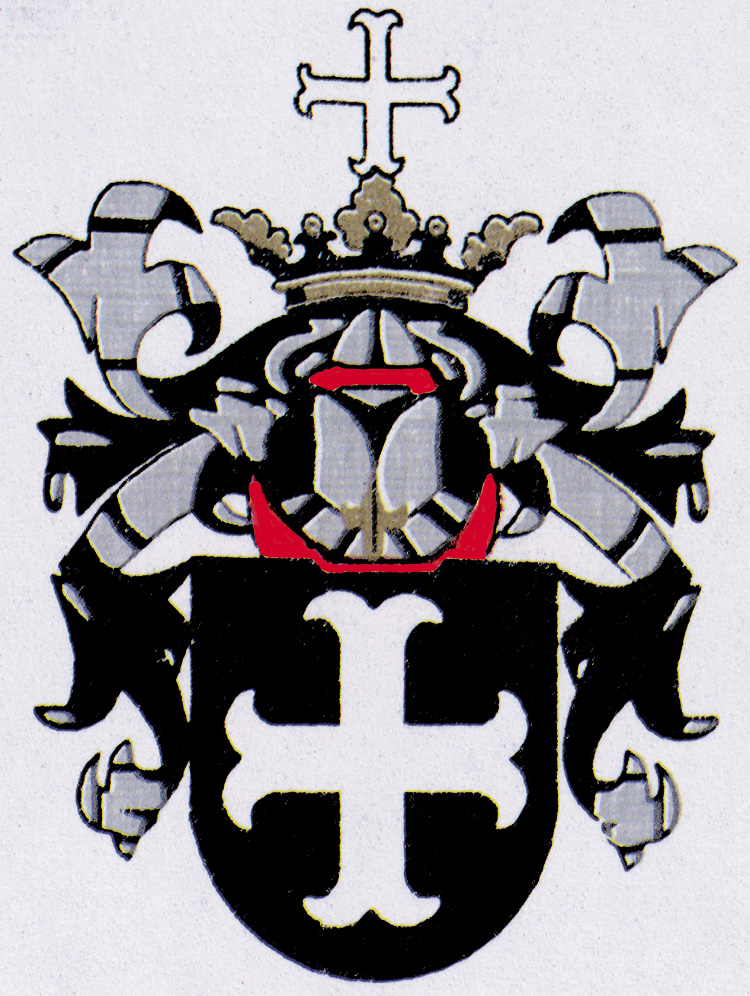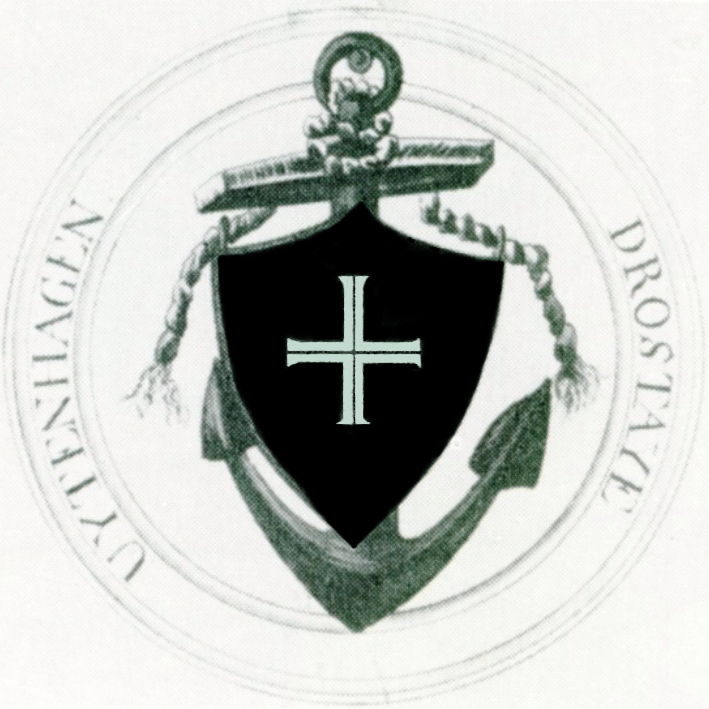

UITENHAGE / TINARHA
Province/state: Eastern Cape (until 1994, Cape Province/Cape Colony).
District council: Western District Council (previously Uitenhage Division; afterwards Dias Divisional Council; then Algoa Regional Services Council).
Additions: Kwanobuhle, KwaLanga (1995).
Incorporated: into Nelson Mandela Metropole, 2000.

Arms registered by the Bureau of Heraldry, Pretoria, on 6 September 1994:
Arms: Sable, a cross moline argent.
Crest: A cross moline argent above a crest-coronet or.
Wreath and mantling: Sable and argent.
The Town Council chose not to adopt a motto.
It is worth noting that although the heraldic tradition of most European countries (except Spain and Portugal) recognises white and silver as being variants of argent, not distinct colours, this letterhead has been printed in both silver and white. One or the other could have been chosen, but the use of both indicates unfamiliarity with heraldic usage.

Arms of 1804:
The arms were first granted to the Drostdij of Uitenhage by the town’s namesake, Jacob Abraham Uitenhage de Mist, who as Commissioner-General was the senior official of the Batavian Republic during its rule at the Cape (1803-06), and outranked the Governor, General Janssens.
During his rule De Mist granted arms to the five drostdijen of the colony as well as to the Raad der Gemeente Kaapstad (Cape Town Community Council).
The pattern for these arms was that of a shield with a single anchor as supporter, and in each case the arms on the shield were those of the town’s founder or namesake.
In other words, this elegant and simple design of a silver cross moline on black was De Mist’s own family coat.
While Cape Town, until 1995, still had the anchor in its arms, the other five towns had long since dropped it. However, the arms of the founder remained until the 1990s the device used in each of the five towns as well as in the Mother City.
Uitenhage attained municipal status in 1841 and assumed the right to the arms of the drostdij.
The town’s arms are identical to those of the Belgian commune of Wezembeek-Oppem, which in turn takes its arms from the Knights of Burbure.
About the town:
The district of Uitenhage (until then part of the Graaff-Reinet district) was created on 25 April 1804 – when the Cape was under the rule of the Batavian Republic – and named by the Governor, General Jan Willem Janssens, in honour of the Commissioner-General, Jacob Abraham Uitenhage de Mist.
Captain Johann Christoph Ludwig Alberti, a Waldecker[1] officer and second-in-command of the garrison at Fort Frederick (now in the heart of Port Elizabeth, but then the only building along the shore of Algoa Bay) was appointed landdrost of the new district and ordered to purchase a farm and lay out a township on it. He purchased the loan farm of Elizabeth Scheepers, widow of Gerhard Scheepers, who had been a pioneer farmer in the southern part of the Graaff-Reinet district. The farm lay along the Swartkops River.
The town was really developed following the departure of the Waldeckers and the Batavian regime.
A New York-born Nova Scotian, Colonel Jacob Glen Cuyler,[2] of the 59th Regiment of Foot, who was also military commander on the eastern frontier, was appointed landdrost to succeed Alberti.
Cuyler’s first task as landdrost was to have a drostdij building erected, but lack of labour (commandeered from farmers in the district) meant that it took eight years to complete. The drostdij still stands, and is today a museum.
A temporary Dutch Reformed church was erected in 1812. In 1819 Advocate De Mist presented the congregation with a large Bible with silver clasps and leather binding.
Work started on a new church in 1820, but it because of legal disputes it was not completed until 1842. The building, used as a church hall since 1927, was proclaimed a historical monument in 1966.
Uitenhage, typically for inland towns in the Eastern Cape during the 19th century, was larger and more important than Port Elizabeth. The first railway in the Eastern Province of the Cape Colony linked the two towns and was formally opened on 21 September 1875. But ironically, it was the arrival of the railways – and more especially the linking of the Cape Colony’s ports first to Kimberley in 1890 and to the Witwatersrand in 1892 – that led to the decline of the inland towns and the rise to first importance of the ports.
Following the municipal elections of 2000, Uitenhage became part of the Nelson Mandela Metropole.
Name of the town:
The name Uitenhage has the same spelling in Afrikaans and in English (although the usual English pronunciation is the rather execrable “Yoo-t’n-haig”).
However, in Xhosa the first vowel has been dropped and the other vowels adapted to Xhosa speech. In Xhosa, the letters RH have the same sound as G in Afrikaans and Dutch, or CH in Scots. The Xhosa form of the name, although long in use, did not become an official name of the town until Xhosa became an official language in 1994.
